The image of a library as solely a silent study space is beginning to shift. And at Richmond schools that shift is no different, with many transforming into “library learning commons” that act as information hubs.
“If you think of a traditional library as a place you would go to get a book or maybe do some quiet research, we’re now thinking about a library learning commons as a place where you go to access different kinds of technologies,” says Rebeca Rubio, the coordinator of libraries and information services for Richmond School District.
With things like green screens, 3D printers and mobile technology, revamped school libraries offer a range of options to students. Movable furniture allows for reconfiguration to facilitate activities like robotics or building that may need more space.
Rubio describes libraries as “the great equalizer,” as they provide services to anyone regardless of their circumstances. She says this element is the same at schools, where students without access to a printer or technology at home can use the resources available in a library.
“If you’re in a (technology education) program, you can learn to 3D print, but if not you may never touch a 3D printer in your entire school career. If you go to the library learning commons at lunch or after school, you can learn from the librarians how to use one.”
And for some students a library is a safe space to seek refuge or find resources.
“If a student is struggling with sexuality or wondering about race, that’s a place where you can find resources as well. That equity and safety piece is also cornerstone to a learning commons.”
The library at Burnett secondary will make use of a $30,000 innovation grant from the school district to help teacher-librarian Dita Verma realize her wishes, with help from student input.
A seminar room has been transformed into a recording studio, complete with microphones and green screens. And a flexible central learning space has doubled as an escape room for some classes.
But the crown jewel of Burnett’s learning commons is its “maker space,” which includes a 3D printer, sewing machine, and electronic cutting machine, among other tools.
Verma says the recording studios are the most popular this year. But “unplugged” activities are also proving to be appealing, including Lego challenges and the Japanese art of amigurumi, crocheting small stuffed yarn creatures. Students also love the revamped reading area, and this year’s COVID-19 protocols allow more students to use the space at a time—although still not up to pre-pandemic levels of use.
Some students come in at lunchtime to be part of talent shows, situated in a corner rather than on a stage. Verma says this reflects the direction the library is headed in.
“It’s being used like a commons, which is the idea of a marketplace where you go into a city and things are happening and you don’t necessarily have a rapt audience watching those performances. Some of them will, but others are just siting there and having their lunch while they listen to some music.”
Ultimately, Verma says flexible and adaptable library spaces are important because they are user-friendly.
“Schools have changed. Our way of instructing students, the way students learn, the way students want to explore. Basically, what a school library looks like now is almost like a public library where you have many different areas, different services that you can tap into, and it is not a classroom,” she says.



